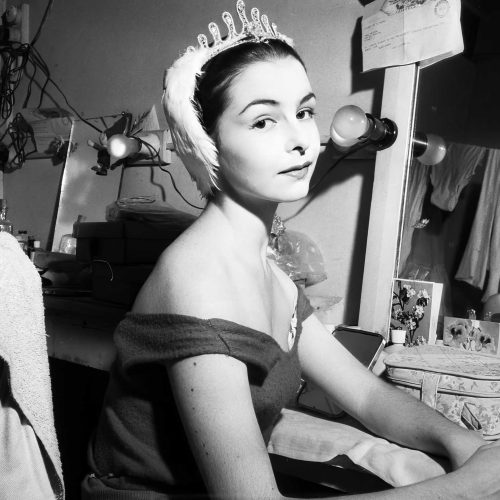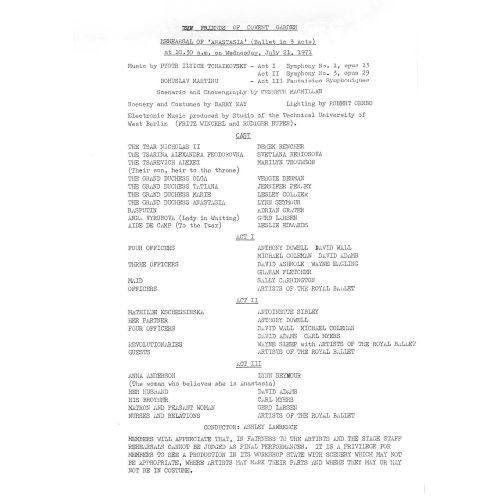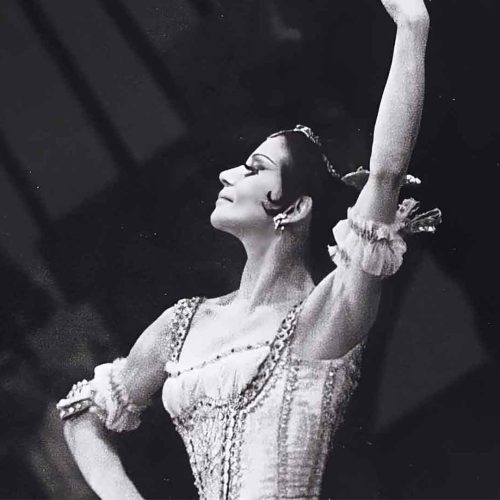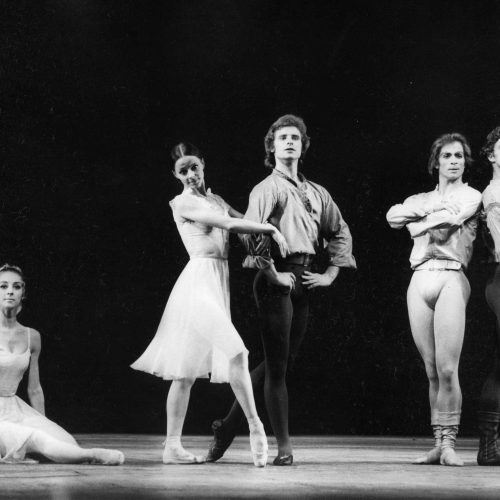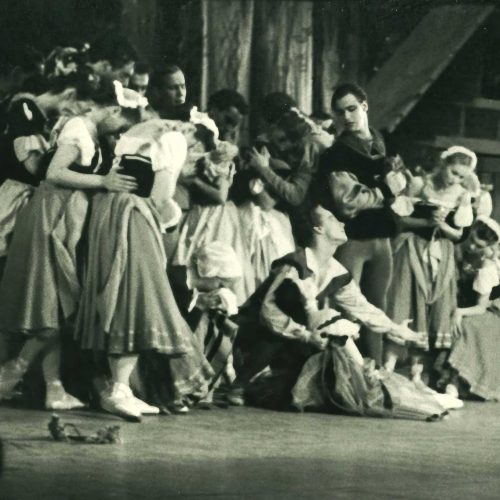Lynn Seymour
In any history of The Royal Ballet, a special place must be reserved for Lynn Seymour, as the dance actress par excellence.
Here she tells Alastair Macaulay about her initial inspiration in her native Canada, and about how she came to the Sadler’s Wells Ballet School at the age of 14. She talks about problems she had with her body and in training, but also about her passionate conviction as to the importance of drama and mime in ballet. This was reinforced when she saw Galina Ulanova with the Bolshoi Ballet in London in 1956. She speaks of the help she received from Winifred Edwards when she was injured, and of the impact Rudolf Nureyev made on her, and later of the importance for her of working with Stanley Williams in New York.
First published: July 15, 2025
Biography
During the mid 20th Century British ballet had a piece of good fortune. In 1953 in Toronto, Lynn Seymour was auditioned by Frederick Ashton for a place at the Sadler’s Wells Ballet School in London, to which she came in 1954.
By 1956 she had joined the Sadler’s Wells Opera Ballet, and The Royal Ballet Touring Company a year later where, in 1958, she created the role of the Adolescent in Kenneth MacMillan’s ballet The Burrow. This was the start of a long association, with Seymour as MacMillan’s perfect muse. Fiercely intelligent and observant, she was never afraid to sum up situations and react accordingly, a rarity in an age of deference.
At a time when it was possible to dance the great classical heroines in quick succession, Seymour was able to absorb and understand what was needed to carry a three-act ballet, something that was going to stand her in good stead in the coming years. By the end of 1959 she had danced Odette/Odile in Swan Lake, Aurora in Sleeping Beauty and Giselle, as a fully-fledged ballerina at Covent Garden.
The next 12 months were defining for both Seymour and British ballet. In 1960 MacMillan choreographed both The Invitation and Le Baiser de la Fée on her and Ashton his ballet The Two Pigeons. Her Juliet in MacMillan’s Romeo and Juliet in 1965, was testament to her unique ability to completely capture the very essence of a role and transpose the mood or idea or argument to something completely believable and absorbing, yet still theatrical and balletic.
From 1966 to 1969, Seymour went with MacMillan to dance the the Deutsche Oper in Berlin, where he was Director. She then returned to The Royal Ballet for another eight extraordinary years, where she created the lead in MacMillan’s Anastasia (1971), Ashton’s Five Brahms Waltzes in the Manner of Isadora Duncan (1975) and Natalia Petrovna in his A Month in the Country (1976) and then with David Wall as Crown Prince Rudolf, she created the role of Mary Vetsera in MacMillan’s Mayerling.
She was a guest artist with many companies, both in Great Britain and abroad and worked with most of the significant choreographers of the age. She also choreographed for various companies and was Artistic Director of both the Bavarian State Ballet (1978-1980) and the Greek National Ballet (2006-2007). Lynn Seymour was uncompromising, innovative, daring and inimitable – a great dancer in any age. She was appointed CBE in 1976.
Transcript
In conversation with Alastair Macaulay
Lynn Seymour: Of course, I was inspired by movies: by Fred [Astaire] and Ginger [Rogers], and especially Fred, of course, and all those dancers and the creativity of it all.
I had seen the Sadler’s Wells Company the year before
Alastair Macaulay: What did you see the Sadler’s Wells Ballet do?
Lynn Seymour: Oh, they did Beauty and the Beast, and they did a lot of [John] Cranko stuff. I was fourteen.
Alastair Macaulay: And by that point you knew that ballet was what you wanted to do?
Lynn Seymour: Yes – I’d seen The Red Shoes, of course, and then the other clincher was, I’d heard all of the Beethoven symphonies one afternoon, sitting in a forest on the north shore of Burrard Inlet in Vancouver (laughter) and I thought I have to live in this world, where this all happens.
Alastair Macaulay: So when the Sadler’s Wells Ballet came, and you auditioned for Ashton?
Lynn Seymour: Yeah. Fourteen, I was. I had to wait a year before I came over.
Alastair Macaulay: They said, ‘Well, we’ll take you at the school’?
Lynn Seymour: Yes.
Alastair Macaulay: So you waited a year, you came, and then you were submitted to the full rigours of British training?
Lynn Seymour: Yes. I was only two years in the school,
Alastair Macaulay: Did it build on what you had?Did it change what you had? Did it go with the grain, against the grain?
Lynn Seymour: To be honest, I don’t-, in terms of technique, I don’t think I learned anything very much, that was useful. I had a very difficult body, actually, because I had, not really very athletic, very weak, and not the kind of muscle that become steely strong, very, very soft. Over flexible joints. And it’s actually not-, although it looks quite nice, it’s a terrific nuisance, because you’re like a-, I always called ‘overcooked noodle’, you know, you’re-, you just didn’t have anything to stand on all the time. And then proportion, you know, I had a very, very short back, so it didn’t counterbalance, sort of, sway backs, and all that kind of stuff. And it led to a lot of tension and difficulties with the upper body, which I had to solve.
Alastair Macaulay: And you don’t feel the Royal Ballet School changed that much?
Lynn Seymour: They didn’t change it at all.
Alastair Macaulay: No?
Lynn Seymour: But I did learn some good lessons there. First of all, I learned a lot about pointe shoes, customising them,,. you sort of remake them to suit your foot. Um, they had two classes that were wonderful there. I forget what the one I loved the most was called, but you did it with these huge hoops, and it taught you the spatial things that the body and all its sections can do. So it taught you about the lines from the proscenium point of view, that you work on the big diagonals, the forward, the de coté, and all the ones in between. And it taught you that you could be travelling one way, but the body could be the other way, and the eyes could be the other, and you had to reach these plateaus, very strict architectural plateaus, that was what choreography was made of. It hit me, big time, these classes. Everyone hated it, because they were just skipping around with these things, you know, but I found it completely enthralling, and you could do so many amazing things. And I was immediately trying to fit this into my ballet class, with the port de bras and the turnout and duh-duh-dah, all this kind of stuff.
The other good lesson was, that, we were taught mime, and you learnt about walking on the stage. You had to come from somewhere, you had to consider the weight of your costume, what status you were in society, and so on and so forth. And I loved all this, especially the idea of weight, and that immediately meant a lot. And also, I could see how that all be fitted in with this spatial thing. So immediately what was interesting me was all these textures, really, that you need to be a dancer, to be Fred Astaire instead of just a hoofer, you know.
Alastair Macaulay: Now if you came in ’54, then you would have seen the Bolshoi [Ballet] when they came in ’56?
Lynn Seymour: Yes, and I was an extra, I forget what I did. I think I was a page boy or something like that.
Alastair Macaulay: So, describe the impact of the Bolshoi?
Lynn Seymour: Oh, Ulanova blew me away. The thing that really got me, was the way she walked in Giselle when she was a bit cross. She completely changed her walk. It wasn’t the way she danced, it was what she did. It was just so subtle, but it described who the character was, and it wasn’t typical of the, kind of, romantic sort of, archaic romantic look that you mostly saw with… dealing with those kind of ballets. For me it was a revelation, and I thought, ‘Way to go!’ you know, I just loved it.
Alastair Macaulay: Now somebody who’s watching some of these performances with you is the young Antoinette Sibley. What’s it like working with another extraordinarily talented ballerina in embryo?
Lynn Seymour: Oh, well, Antoinette was the star of the class. She was fantastic. She was a totally different kind of dancer to me, she epitomised what was the best of the British training then, and she had the right kind of body to benefit from it. I used to try and stand behind her all the time, because she had the most marvellous, as you know, neck and back, and I had a little tiny short back and neck like this, a little stubby, next to her swan-like, sort of, appendages. I used to stand behind her to try and get that feeling, you know, just to remind me all the time at the barre, you know, don’t let that go, because it’s so important. She was the absolute star of the class, everybody knew it.
Alastair Macaulay: Now, in some of your, the biographies of you, you talk about Miss Edwards?
Lynn Seymour: Yes, now she was one of my teachers at the School, but it was really later that she was very kind.
Yes, it was when I left the Touring Company. I was injured, I had an Achilles tendon injury, and it was no way to come. The big lesson she taught me, first of all, her kindness was enormous, and her encouragement, you see. I didn’t learn much in the way of technique, but she taught me to work alone, and it was a fabulous, fabulous thing to learn. Um, I didn’t really start to learn any technique until Rudolf started coming.
It was such a breath of fresh air. I had moved to the main company, and I was very unhappy there. But then Rudolf came, and we, we just hit it off right away
So that was the beginning of my education with him. And then he would send me, it was [Alberto] Franchetti in Paris, off we went, I’d be going every weekend, or as often as I could. Finally, a teacher, you know, that’s gonna, talking to me. And then we were on tour in America, and then it was [Valentina] Periaslavic and I was going to New York as often as possible to work with Perry. All pushed through from Rudolf.
Alastair Macaulay: And is it Rudolf who leads you to Stanley Williams later on?
Lynn Seymour: And of course, it’s Stanley.
Now this is magic. He was like a nuclear physicist who, you know, what they’re trying to do in CERN right now, they’re trying to split neutrons or something, you know, he was like that with the technique, and it was all to do with timing and phrase. So it wasn’t to do with the step, it was to do with starting the right way, with everything ready to go, and then, and going, you know, but at the most finite time. And in this way, you learned about turning out, you learn about jumping, you learn about stability, you learn about movement, you learn everything. And it’s not overcrossing that they do, it’s turning both sides of your body out. And sometimes in order to do that you need to find your centre, and in order to do that, you sometimes, especially somebody like me, with swayback knees, you have to overcross your fifth, because until you do, you’re not… you don’t find your centre.
Alastair Macaulay: That connects to the [George] Balanchine dictum
Lynn Seymour: Totally.
Alastair Macaulay: When people talked about upper and lower, he would say, ‘The body is divided into two halves, but not upper and lower, left and right.’
Lynn Seymour: Exactly, exactly.
Alastair Macaulay: The turnout down the vertical axis, the whole body.
Lynn Seymour: Absolutely, absolutely, absolutely. You turn your ears out, you turn your eyelashes out, you turn your hairs on your head out. It’s like a way of being. It’s not a position, it’s an act. It’s a way of going, if that makes any sense to you.
Alastair Macaulay: No, that’s beautifully put.
Lynn Seymour: It’s like the spiral, it’s like the genome. It’s the secret to the whole… so much. Once I started to get this, I started to have a technique, and I was already well into my thirties. I can remember, I did a Giselle at the Met, and I’d been working with Stanley a lot, because we’d been there for a month or so, and I’d had him every day. I came off the stage, and I’ve never felt like it ever before, I thought, ‘I could do it again, now.’ That was the difference. I wasn’t walking out on my hands and knees as usual. It’s the absolute Holy Grail of getting it together.
The transcript of this podcast may have been lightly edited for ease of reading.

